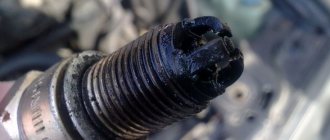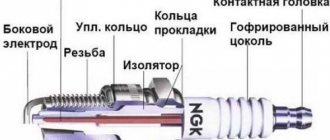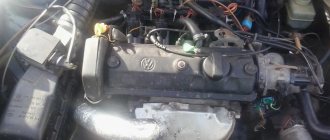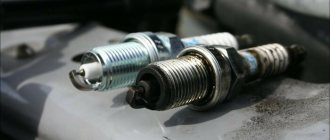Flooded, wet spark plugs after starting - this situation is familiar to almost all owners of cars with carburetor engines. At the same time, starting the engine with flooded spark plugs is very problematic. If you unscrew the spark plugs at this moment, they will be wet and filled with gasoline, which in most cases is a consequence of the very rich enrichment of the fuel mixture during the start-up mode.
List of the main reasons leading to flooding of spark plugs
— Starting a hot engine on choke.
Starting a warm engine with the choke handle extended towards you and the air damper closed will lead to a strong enrichment of the fuel mixture in this mode and, as a result, flooding of the spark plugs.
air damper open during hot start
— The carburetor starter is faulty or not adjusted.
The problem mostly concerns cold starts. It is necessary that the starting gaps “A” and “B” are set exactly, that is, the starting device is adjusted. In addition, the PU diaphragm mechanism must have a complete, unbroken diaphragm and have a sealed housing. Otherwise, when starting a cold engine, the carburetor air damper will not open slightly (this is the whole point of the control unit), forcibly depleting the fuel mixture with a portion of additional air. The absence of such an opening will lead to excessive enrichment of the fuel mixture when starting a cold engine and the spark plugs will flood.
visible elements of the Solex carburetor starting system
— The spark plugs are faulty.
“Punctured” spark plugs with black carbon deposits and an incorrect gap between the electrodes will not be able to ignite the rich fuel mixture entering the cylinders during the start-up mode and will be immediately filled with gasoline. It is advisable to have a spare set of spark plugs so that if necessary, you can quickly change them. Faulty spark plugs can become flooded with fuel, both during cold and hot starts.
— The needle shut-off valve in the carburetor float chamber is faulty.
The float chamber needle valve may be leaking (either from wear or a defect) and allow excess fuel into the float chamber, which in turn again leads to an over-enrichment of the fuel mixture during start-up mode. Moreover, due to a faulty needle valve, the spark plugs can be flooded both during a cold start and during a hot start. Very often, a leaky valve produces a constant smell of gasoline in the engine compartment and fuel leaks on the carburetor. It is recommended to check the serviceability of the needle valve and, if necessary, replace it with a new one.
checking the Solex carburetor needle shut-off valve
— Pumps the fuel pump.
The fuel pump may over-pump due to an incorrectly adjusted drive. The excess fuel pressure it creates on the needle valve will lead to fuel overflow and an increase in its level in the float chamber, which in turn will lead to excessive enrichment of the fuel mixture. It is necessary to check and adjust its drive.
protrusion of the pusher required for proper operation of the fuel pump
— The GDS air jets are clogged.
GDS air jets supply air to the fuel mixture, allowing it to have the desired proportion (gasoline/air) required for reliable engine starting. A decrease in the amount of incoming air or its absence altogether due to clogged air jets leads to a strong over-enrichment of the fuel mixture and subsequent flooding of the spark plugs. See “In-Place Carburetor Cleaning.”
air jets GDS carburetor Solex
— Poor evaporation of fuel vapors in cold weather.
In severe frost, fuel volatility (fuel vapor ignites during startup) is greatly reduced. The fuel settles on the walls of the intake manifold and enters the combustion chambers and floods the spark plugs. Before starting, it is recommended to press the gas pedal several times and wait 15-20 seconds and only then start the engine. Some drivers spill boiling water on the outside of the intake manifold and only then start the car engine.
Notes and additions
— If the spark plugs are filled with fuel, but you still need to start the engine right now, without troubleshooting, then it is recommended to do the following. We turn down the choke, press the gas pedal all the way and crank the engine with the starter for several seconds. In this case, the throttle valves of both carburetor chambers will be fully open, the mixing chambers will be subjected to strong purging, and the spark plugs will dry quickly. You can repeat this “purge” a couple of times at intervals of a minute (if the battery allows) and then try to start the engine again.
More articles on car engine malfunctions
If one fine morning you find that your car is difficult to start, or even the engine refuses to start at all, then most likely your spark plugs are flooded. In this article we will try to answer the question why the spark plugs on VAZ cars are flooded, and what to do about it? The solution to this problem is quite simple and can be done by any car enthusiast.
Cause of faulty spark plugs
Floods candles, most often during cold weather. Especially noticeable in late autumn. Sometimes it is possible to start the engine, but it runs erratically and for a short period of time. When you try to accelerate it (press the gas pedal), it stalls for a second and a sharp bang is heard in the exhaust pipe. This phenomenon is dangerous, as it can disrupt the ignition timing.
The first thing the driver does in this case is check the color of the spark plugs. The threads and electrodes are in most cases covered with black carbon and are too wet - all this means that the spark plugs are flooded.
In this case, it does not depend on what type of engine you have (injection or carburetor), the problem manifests itself equally in both engines. To determine the source of the problem, you need to understand how the engine starts.
The process of starting the engine is as follows: the starter spins the crankshaft flywheel and sets in motion all the important organs of the engine. These include the camshaft, valves, and at the same time, spark production begins at the ends of the spark plugs. At this time, the gasoline pump pumps a mixture of gasoline and air, which enters the combustion chamber. At the moment fuel is supplied to the chamber, a spark is formed on the electrodes of the spark plug (at the correct ignition timing), which ignites the mixture and creates a small explosion, which, in turn, moves the piston inside the cylinder.
It becomes clear that if a spark does not appear, then the mixture simply floods the spark plug, which is no longer able to produce a spark. Ultimately, it becomes covered with a layer of soot, and the remains of unburned gasoline explode in the exhaust pipe, creating an unpleasant sound that many car enthusiasts are so afraid of. This phenomenon is associated with a malfunction of the spark plugs, so before looking for the problem in other places, you should check for the presence of a spark. To do this you need to use a special gun.
Prevention
For normal operation of the ignition system, it is necessary to create certain conditions for the engine, especially in winter, under cold start conditions:
- before cold weather, change the spark plugs (it’s better to carry a good old set with you for replacement in case of filling), change the fuel filter, service the battery;
- monitor the battery charge, charge the battery;
- monitor the serviceability of the starter and prevent it from jamming;
- promptly, once every 100 thousand km, clean injection nozzles on a special stand;
- change the engine oil according to the regulations, if necessary, flush the lubrication system with decoking of the piston rings;
- regularly check the condition of the spark plugs, change them to platinum or iridium every 15-20 thousand km;
- choose high-quality gasoline with the maximum permissible octane number, keep the tank full in winter;
- Remember that prolonged operation of the engine in IAC, driving at low revs, at low speed, and insufficient engine warming up lead to carbon deposits. Drive onto highways, “spinning” the engine to 3500-5000 rpm so that carbon deposits and deposits burn out in the chamber and the spark plugs are cleaned.
Our dismantling shop offers high-quality spare parts for your car.
Go to search
Tags: fault diagnosis
Video - VAZ injector fills spark plugs
The second problem includes a weak ignition pulse, which is not enough to create the required ignition spark, and weak compression in the cylinders. However, such difficulties can arise when operating a carburetor engine. In this case, the engine undergoes expensive repairs.
Incorrect adjustment of the amount of air and gasoline can also affect an injection engine. Incorrect operation of the controller, especially in cold weather, leads to the fact that the software does not perform the computing function well and the injector supplies gasoline and air in completely incompatible quantities. As a result, the candles are flooded in the same way and lose the ability to further ignite the mixture.
Other reasons
In addition to the already mentioned main reason for flooding candles, there may be others:
- When starting, the crankshaft turns slowly (we are repairing the crankshaft).
- The malfunction lies in the valve stem seals, which allow oil to pass through (we change the valve stem seals).
- The injector is clogged, but continues to supply gasoline and fills the spark plugs with it (we clean the injector).
- Water appears in gasoline (this happens most often in winter, we choose the right brand of gasoline - “winter” or “summer”).
What to do if the candles are flooded?
If the spark plugs are flooded and you need to start the engine as soon as possible, then you can forget about all the above reasons and start the engine using several methods.
- This method is prescribed in many operating instructions. To do this, the spark plugs are unscrewed using the appropriate wrench and dried. For drying, you can use a regular gas stove. After the candles become dry, wipe them with a dry cloth, thereby eliminating new carbon deposits and screw them into place.
- The second option also came to us from old carburetor cars. The essence of this method is to dry the candles without dismantling them. The method works equally on both injection and carburetor engines. The gas pedal is pressed all the way to the stop, and the engine is spun up using the starter for 10 seconds. Thus, the gasoline supply is shut off, and the engine cylinders begin to be purged with air alone. In this short time, the candles have time to dry quite well. During the purging process, you must release the gas pedal. After this action, the engine can usually be started without problems.
- If all else fails, check for spark. To do this, one of the armored wires is pulled out and leaned against the cylinder head by 4-5 millimeters. Have an assistant turn on the car's starter for a short time. If a blue spark jumps between the wire and the cylinder block, then the spark plug is serviceable. However, there are spark plugs that may not work on a particular type of vehicle. Try installing new spark plugs. In most cases, this method almost always works. If there is no spark, then the fault lies either in the armored wires, or in the Hall sensor, or in the switch itself and the ignition coil.
- If the first start of the engine is unsuccessful, then you need to wait a certain pause. Usually it is 5-10 minutes. This is done in order to avoid flooding the candles. As for carburetor cars, experienced drivers recommend making the first start without closing the throttle. To do this, start the car without choke and vigorously press the gas pedal to give it the opportunity to warm up the combustion chamber. After this, the damper closes, and it is not recommended to touch the gas pedal.
These methods allow you to start the engine only when it is urgently needed. If your VAZ spark plugs flood quite often, then it is necessary to diagnose the fuel supply system and, if possible, repair or adjust it. Do not tighten under any circumstances, as if there is a non-combustible residue, the oil scraper rings will fail.
That's all. Perhaps, the whole range of measures is listed here that will help you revive and start the engine in the cold, even with flooded spark plugs. This event is carried out independently, so any driver should know about it.
Why are the candles flooded ? The answer to this question depends on what kind of process fluid they are filled with - gasoline, oil or antifreeze. In the first case, a weakly charged battery is most often to blame. In the second and third, there are problems with depressurization of the engine lubrication and cooling systems.
Features of starting a car in cold periods
In cold weather, before starting, you must first load the battery, then disconnect it for a while. After waiting a few minutes, you can try turning the starter to start the engine. If you fail to start the car on the first try, then in order not to fill the injector, you must wait a few more minutes. If all preventive measures were carried out in full before the frost, then there should be no problems with filling fuel.
We can list several conditions that are considered optimal for normal operation of the injector:
- presence of a working starter;
- maximum battery charge. The battery is powerful and in good condition;
- seasonal lubricant is used;
- spark plugs and high voltage electrical circuits must be in perfect condition;
- clean, adjusted nozzles are installed;
- The gas tank is filled with high-quality fuel.
There is an opinion among experienced drivers that driving a car along a highway at a speed of 120 km/h promotes self-cleaning of automobile systems, including the fuel system. You can also run the engine at 5000 rpm for about 10 minutes in the morning. The effect is similar to racing on a track.
It is believed that when high pressure is created in the systems, self-cleaning occurs. These measures can only be carried out if the car is in good condition and a significant increase in pressure in the systems will not harm it.
What steps do you need to take to get started?
The question arises, what to do if the car is not old, all systems are in order, but in the cold it refuses to start? When turning the spark plugs out, it turns out that they are wet. As already mentioned, in the cold season, the cause of this phenomenon may be weak compression, low-quality fuel or a weak battery.
Let's look again at the manufacturer's instructions. The book on car operation defines the following algorithm of actions:
- Turn out the spark plugs.
- Wipe them thoroughly and dry them.
- Run the starter for a few seconds.
- Put everything in place.
Often, car owners clean the injector using various fuel additives. This is not recommended at all, firstly, the quality of the fuel mixture is lost, which negatively affects the operation of the entire piston group, and secondly, the injector should be cleaned using special equipment.
Experienced drivers carry several sets of spare spark plugs with them . The quality of the spark produced depends on the technical characteristics of this ignition component. There is no point in saving on candles, their cost is not that high, and low-quality candles can cause a lot of problems.
How to understand that the candles are flooded
First of all, you need to define the concept of “drenched candles”, that is, what is it? One of the main operating cycles of a gasoline internal combustion engine is the supply of a fuel-air mixture to the combustion chamber and its subsequent ignition. When, for some reason, the spark plug does not light it, this is called “flooding the spark plugs.”
And all because a large amount of fuel gets into the electrodes and the spark plug body. And the more fuel that gets there, the more difficult it is to ignite it, although in practice this is almost impossible until they are dried.
Most often this happens during the cold season, during significant frosts or simply during cold snaps. As drivers say, “in the cold.” During such a period, there is a heavy load on the battery and if it is weak, then there is always the possibility of flooding the spark plugs. That is, the driver tries to start the car two or three times, while the battery is discharged and the spark plugs are filled with gasoline.
However, spark plugs can be filled with more than just gasoline. two other process fluids can get on it - engine oil and coolant (antifreeze or antifreeze).
Indirect signs that the spark plugs are filled with engine oil are the following situations:
- rapid decrease in oil level in the engine crankcase;
- Unstable engine starting, and at any time of the year;
- decrease in the dynamic characteristics of the car, poor acceleration, drop in power;
- Unstable engine operation at idle speed;
- "triple" of the engine.
It is necessary to understand that the listed signs may indicate other breakdowns in the engine, so it is better to unscrew the spark plug/s from its seat and visually assess the condition of its electrodes and insulator. Moreover, it is advisable to check both for the presence of burnt oil and for the general condition. Much can be understood by color.
Similar signs will indicate that the spark plug is filled with coolant (antifreeze). In this case, there will also be a drop in engine power, a rapid drop in the coolant level, and the appearance of white carbon deposits on the spark plug electrodes and/or its insulator. You may also notice the appearance of white smoke from the exhaust pipe.
Gap
When performing a preventive check of spark plugs or while searching for the causes of an unstable engine, it is recommended to check the gap between the electrodes.
- If the gap is larger than normal, the spark will form more than usual, the mixture will begin to ignite more strongly, and the flow rate will be more stable. In this case, failures in the operation of the motor may occur.
- If the gap is smaller than required, the spark will begin to appear earlier than required. The small spark energy is not capable of effectively igniting the fuel mixture. This increases fuel consumption, but reduces engine power and worsens dynamics.
The gap between the electrodes on the injection VAZ 2110, according to the manufacturer’s recommendations, ranges from 1 to 1.13 millimeters.
Gap measurement
Setting the gap
The first step is to check whether the gap really deviates from the norm, and then take appropriate action. So, let's begin.
- Get to the spark plugs, having first disconnected the high-voltage wires from them.
- Use a feeler gauge to measure the distance between the two electrodes of your spark plugs. Special probes are sold that look like a folding knife.
- Take a feeler gauge whose blade is exactly 1 mm thick.
- Insert the probe into the gap between the electrodes.
- Normally the blade should go in with a slight pinch, but you don't have to use much force to get it in.
- If the blade is too loose, then the gap is too high. You will need to lightly press the upper electrode against the lower one until the required distance is formed.
- If the blade is difficult to fit into the gap, then it was smaller than required. In this situation, you will have to do the opposite, bend the electrode slightly.
Adjusting the distance
When increasing or decreasing the gap, do not apply too much force, otherwise you risk breaking the element. In this situation, there is nothing left to do but change the spark plug.
Why does the candles flood?
The reasons for flooding spark plugs depend on what kind of process fluid they are actually filled with. Let's look at them in order.
Fills candles with gasoline
The most common problem is flooding with gasoline. There are most often 3 reasons for this situation.
Low battery charge
If the spark plugs are filled with gasoline “when they’re cold,” then most often a discharged battery is to blame. This can happen in different conditions, both in the warm season and in the cold. However, in winter this happens more often, since in the cold the battery loses some of its capacity and discharges faster.
With each turn of the key, fuel is injected, but when the spark is weak or completely absent, the spark plugs are filled with more and more fuel by such actions. Such a candle is guaranteed not to give a spark until it is dried.
Fuel failure
Carburetor engine
In older carburetor engines, the reason that the engine fills the spark plugs with gasoline may be due to incorrect settings of the carburetor itself. As you know, this unit requires fine tuning, and over time this tuning may get lost. The carburetor simply pours too much fuel into the cylinders, and it does not have time to ignite. In the warm season, with this setting you can still start the engine, but in cold weather this can become a problem.
Injection engine
In injection engines, the ECU (electronic control unit), which operates based on information from several sensors, is responsible for the amount of gasoline supplied. As the temperature drops, it commands more fuel to be supplied through the injectors to enrich the air-fuel mixture. Thus, starting and the amount of fuel supplied completely depends on their serviceability. Responsible for cold starts are the coolant temperature sensor, TPS, IAC and air flow meter.
For cars equipped with an absolute pressure sensor (MAP sensor in English), this sensor is also responsible for the fuel supply, so its failure leads to flooding of the spark plugs when there is a spark. Often, the Check Engine warning light on the panel lights up, and using an error scanner you can read errors P0106, P0107, P0108, P0109.
If the spark plugs are poured while hot, then the reasons may be: bad/faulty spark plugs (breakdown, gap violation), breakdown of explosive wires or other elements of the ignition system.
Fuel with condensate
When temperatures change, condensation (water droplets) forms. Also, water in gasoline can get into the tank and at the gas station. Water naturally does not burn, and gasoline with such an admixture does not ignite well. To avoid such a situation, fuel dehydrators are used in winter and autumn.
Fills candles with oil
Less common, but also more dangerous, is filling the candles with oil. This is caused by more significant breakdowns of individual engine components. Oil can enter the cylinders (on the electrode and threads) either through the rings or through the valves. When the spark plugs are in oil on top, either the sealing rings of the wells are leaking or the valve cover gasket is leaking.
Valve guides
If the working surfaces of the valve guides are significantly worn, their play may occur. Specifically, between the valve stem and the valve guide. Because of this, oil can flow from the cylinder block directly into the combustion chamber onto the spark plugs.
The situation can become more complicated if this is not the first such case when the bushing comes out of the body of the head. Typically, in such situations, a repair sleeve is used instead of a regular one, since it has a larger diameter. But if regular bushings were installed instead of repair bushings, then all this together leads to the consequences described above.
Valve seals
As for valve seals, they can leak oil into the combustion chamber for various reasons. Among them:
- Increasing the rigidity of the crimping part of the seals. For normal removal of oil, they must be relatively soft. Tanning often occurs due to natural aging or frequent overheating of the engine.
- Failure of the crimp spring. It can stretch significantly, become damaged, or simply jump off the oil seal body.
- The oil seal itself has risen significantly from the body of the guide sleeve.
- If the bushing has significant wear, the valve may tilt to one side. Accordingly, on the opposite side, oil can leak from the cylinder block into the combustion chamber.
As a rule, in the situations described, oil gets not only onto the electrode, but is also located at the beginning of the spark plug mounting thread.
Piston rings
Wear of the piston rings automatically leads to oil leakage from the crankcase into the combustion chamber. In addition to simple wear, a situation is possible when the ring (rings) simply burst, which renders it virtually unusable. Or it’s simply stuck, here you can try to decarbonize it. When checking piston rings, it is advisable to check the compression in the engine cylinders.
Clogged oil system ventilation
The VKG system ensures normal oil consumption on a working engine. When it becomes clogged, the pressure of the crankcase gases increases, which leads to the fact that the piston rings will not cope with their tasks, which is why some of the oil will enter the combustion chamber.
Intake manifold gasket
Some cars have their own “childhood diseases” that appear specifically on them. For example, Renault Megane 2 spark plugs may be filled with oil due to a broken intake manifold gasket. However, this can happen on other machines as well.
Oil in spark plug wells
Not all cars have spark plug wells, but for example, on a VAZ-2112 with a 16-valve 1.6-liter engine, on Priors, Focuses, and Chevrolets, spark plug wells filled with oil are a very common occurrence. The reasons why oil may end up in the spark plug well may be as follows:
- poor valve cover seal;
- wear of sealing gaskets of spark plug wells.
The spark plugs are filled with antifreeze
The reasons why the spark plugs are filled with antifreeze are completely similar to the reasons why the antifreeze itself gets into the engine oil. Let's briefly list them:
- Damage (burnout) of the cylinder head gasket. Occurs from aging, mechanical damage or overheating.
- Violation of cylinder head geometry. The popular name is “moved its head.” The situation arises mainly due to significant overheating of the motor.
- Damage to the cylinder block. In particular, cylinder walls, the appearance of microcracks.
Symptoms of a problem
If the spark plugs fail, there will be no spark. Consequently, the fuel mixture will not be able to ignite, the engine will freeze and show no signs of life.
There are several telltale signs that may indicate poor spark plug performance.
- The engine starting procedure gets worse. The starter turns, but the motor itself does not respond;
- Fuel consumption increases;
- CO emissions increase;
- At idle and while driving, the engine begins to jerk the car;
- The dynamic performance of the car drops, it is not possible to raise the speed to the required maximum, the engine power noticeably decreases, etc.
Article on the topic: Replacing a lambda probe on a VAZ 2114
But all these are indirect reasons, since they do not directly indicate the failure of the spark plugs. You can verify their malfunction only by checking.
What to do if the candles are flooded
Measures to eliminate the malfunction directly depend on the reason why the engine is flooding them. Let's look at them in the same order.
When filling with gasoline
The first thing you can do is purge the cylinders for 10 seconds by opening or partially opening the throttles, making the mixture lean. You can also unscrew the spark plugs and clean, burn out (dry), and also check the gap and any other visible damage. It would also be a good idea to have a multimeter on hand to check the voltage at the battery terminals, it may be too low.
Choice
The choice of candles today is quite extensive. But we’ll talk about which ones are used for the VAZ 2110 and what can currently be considered the best choice for your car.
Candles differ from each other mainly in the material from which the electrodes are made.
| Candle type | Peculiarities |
| Copper | These are classic spark plugs for VAZ, installed by the factory. The operating life is up to 50 thousand kilometers. Some of them are coated with yttrium alloy to increase the reliability of the electrode. |
| Platinum | They are characterized by increased resistance to temperature fluctuations and corrosion, which has a positive effect on the service life of the elements. Such elements are capable of operating up to 90 thousand kilometers |
| Iridium | The characteristics are in many ways close to platinum candles; today they are considered the most durable and high-quality. Safety margin - about 90-100 thousand kilometers |
The service life may increase or decrease depending on the care, conditions of use of the vehicle, and the quality of the fuel being poured.
Platinum candle











